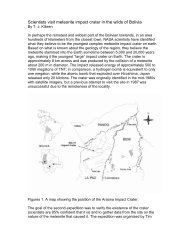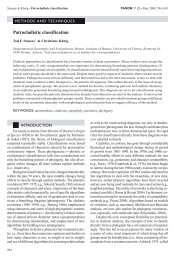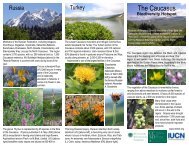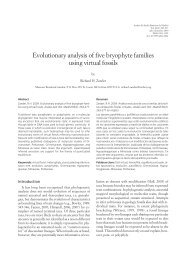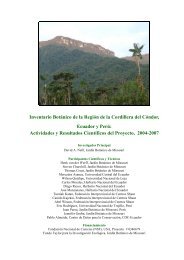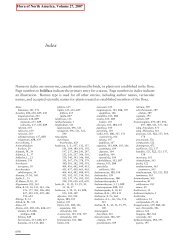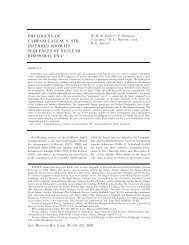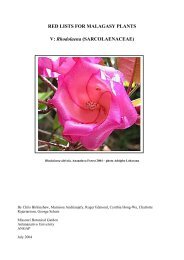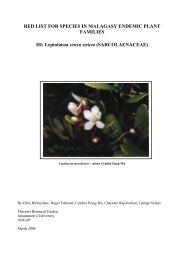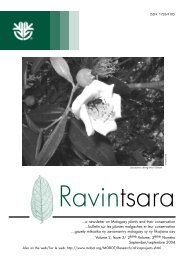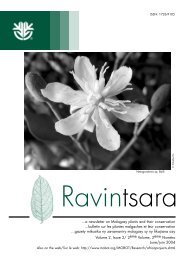red lists for malagasy plants iv: sphaerosepalaceae - Missouri ...
red lists for malagasy plants iv: sphaerosepalaceae - Missouri ...
red lists for malagasy plants iv: sphaerosepalaceae - Missouri ...
You also want an ePaper? Increase the reach of your titles
YUMPU automatically turns print PDFs into web optimized ePapers that Google loves.
Rhopalocarpus parvifolius (Capuron) Schatz, Lowry & Risk of extinction: Critically Endange<strong>red</strong> (A3c, B1ab, C1)<br />
Wolf<br />
Vernacular names: Tavialahy, Havoha Conservation recommendations: a) inclusion of populations in<br />
new conservation sites; b) ex-situ conservation.<br />
Description:<br />
Like R. louvelii but leaves small with petiole less than 5 mm<br />
long.<br />
Habitat:<br />
• Vegetation type: littoral <strong>for</strong>est<br />
• Bioclimate: humid<br />
• Geology: unconsolidated sands<br />
• Altitude: 10 m<br />
Biology:<br />
• Pollination: probably insect (on basis of flower<br />
characteristics and observations of bees visiting flowers at<br />
Ambila Lemaintso)<br />
• Seed dispersal: probably lemurs (based on fruit<br />
characteristics and observations of lemurs feeding on the<br />
fruits of other Rhopalocarpus species)<br />
Uses:<br />
Timber.<br />
Distribution:<br />
Observations of study population(s)<br />
• Location: SF Ambila Lemaitso (18°52’15’’S, 49°08’11’’E)<br />
• Regeneration observed: Yes<br />
• Tolerant to disturbance: No<br />
• Density: 1 mature ind<strong>iv</strong>idual per ha.<br />
• Abundance: 50 - 250 mature ind<strong>iv</strong>iduals<br />
P<strong>red</strong>icted future decline:<br />
• because of habitat loss: >80% (because of fire and shifting<br />
cult<strong>iv</strong>ation)<br />
• because of exploitation or poor regeneration: unknown, but<br />
decline possible because of exploitation and poor regeneration<br />
resulting from increasing rarity of animal seed dispersers.<br />
Distribution attributes <strong>for</strong> population<br />
• Extent of occurrence: 36 km²<br />
• Area of occupancy: 27 km²<br />
• Number of subpopulations: 3<br />
Representation in protected areas:<br />
• Number of subpopulations: 0<br />
• Protected areas: None<br />
Specimens examined: Toamasina: Ambila-Lemaitso SF, SF(Leman<strong>iv</strong>o) 1624 ; Ambila-Lemaitso SF, SF(Ecol.Forest.) 1795 ; Ambila-Lemaitso SF, SF 19005 ;<br />
Ambila-Lemaitso SF, SF 15316 ; Ambila-Lemaitso SF, SF 9715 ; Ambila-Lemaitso SF, SF 19243 ; Ambila-Lemaitso SF(R. Capuron) 8569 ; Ambila-Lemaitso<br />
STF, SF 17996 ; Andavakimenarana, Fidy Ratovoson et al. 22 ; Vohibola <strong>for</strong>est, Richard Razakamalala 290 .<br />
25





